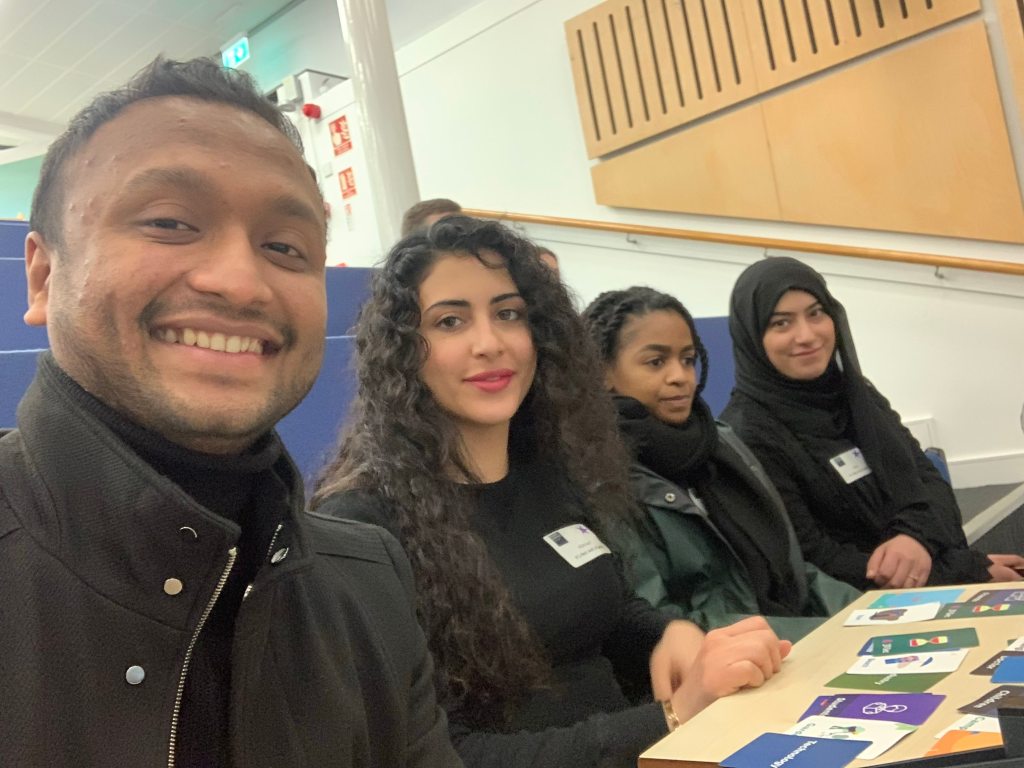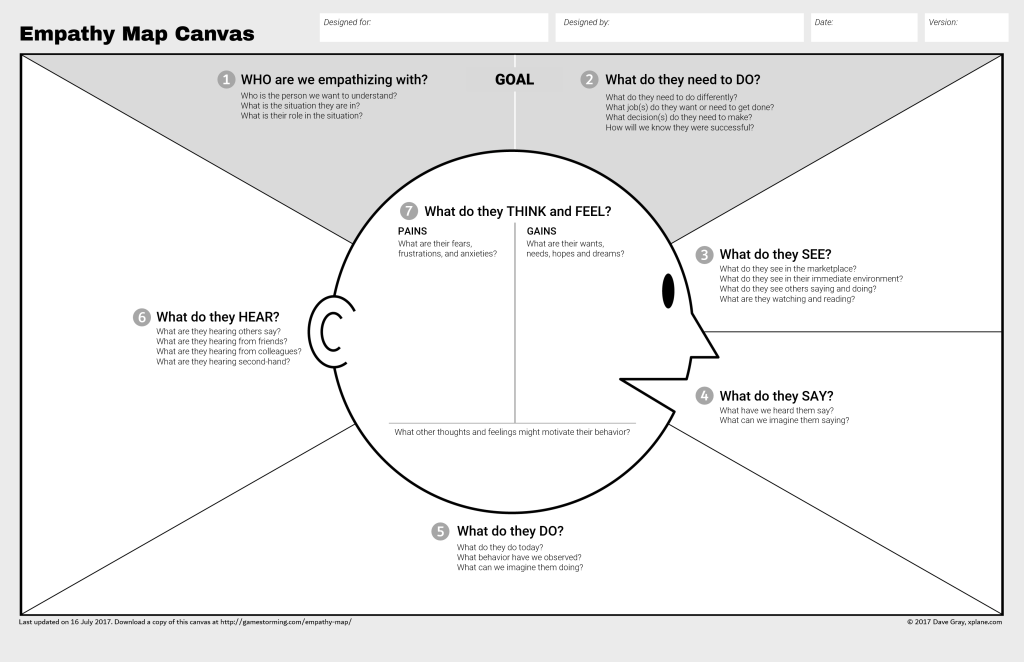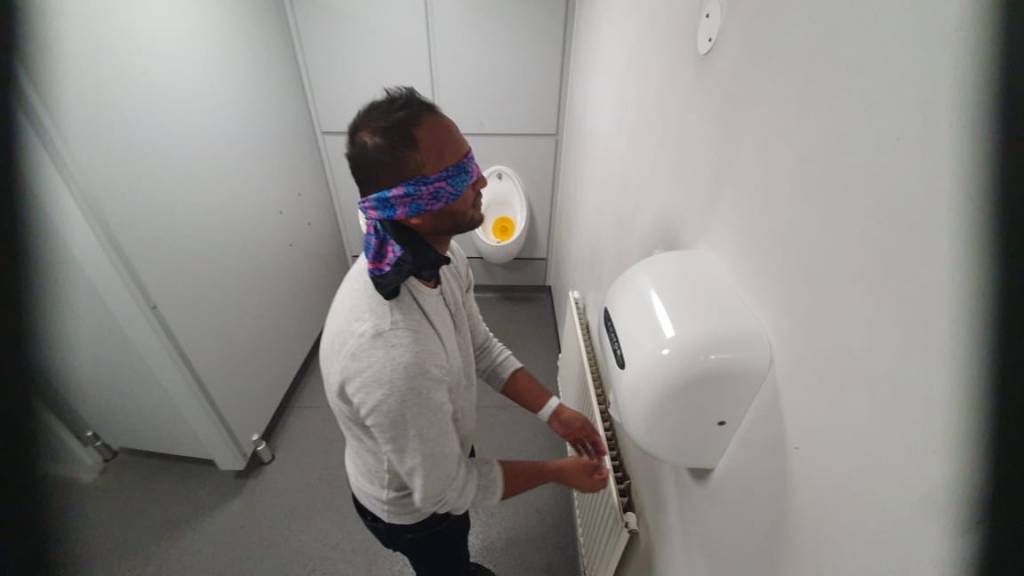As social entrepreneur, the decision to take a yearlong leave from work to pursue a second master’s degree, was a difficult one. I was aware that it meant leaving the close work with the Bangladeshi community and creating an impact on society to some extent behind.
In 2018, I decided to pursue my second master on Innovation Management and Entrepreneurship, with three main intentions.
Firstly, I wanted to improve my personal and professional skills and extend my experience. Studying this subject would provide me with tools and theoretical aspects of entrepreneurship and innovation. Secondly, I want to share my learnings and knowledge by mentoring and coaching others to lead them to success. Thirdly, my goal is to give university lectures, as innovation and entrepreneurship as a subject is very new in Bangladesh and universities are just starting to tread on this pathway. I believe my educational background and experience will provide me well to teach.
No matter if we are working for a startup or a company, there are some attributes of the entrepreneurial journey that follow more or less a similar process.
This reflective essay summarizes my learnings throughout the design thinking module from day 1 to the last day of the class, providing me with theorical and practical knowledge ranging from ideation to product selling. I believe these learnings will be beneficial for my professional future, be it for my upcoming startup or a leading position within a company.
In the last 7 months, I have learnt essential business tools, could further develop myself and my skills, and picked up many insights regarding entrepreneurship.
This reflection shall also provide a reference for my future self. Whenever I would like to remember some of the learned tools or how to overcome challenges, this essay will serve as a self-teaching tool containing the insights I gained.
For the purpose of self-reflection and self-learning, I have divided my entrepreneurial journey in three categories:
- Business Tools
- Personal Growth &
- Entrepreneurship
BUSINESS TOOLS
I acquired many important tools and techniques during my Design Thinking module. I believe I will be using these tools for future business, and this collection will make it easier for me to look them up and refresh my memory.
Empathy, Observation, Brainstorming and Prototype
Empathy is the ability to understand another’s feelings and thoughts, without having similar ones (Battarbee, Suri & Howard, 2020). By observing people, we can identify customers’ needs and gain insights.
This process is always conducted by interviewing the customer. After identifying the needs, it is essential to create a Point of View statement (d School, 2009), which is an actional problem statement. It helps to categorize all problems/needs. After selecting the problem, the team needs to brainstorm (IDEOU, 2020) about the possible innovative solution for these problems. The next step after this is prototyping, which creates a Minimum Viable Product (Aghnia & Larso, 2018) of the solution to test it with potential users and take the feedback into account to develop the product.

I have practiced this process with my team through the task of designing new shoes for our customers. We went interviewing extreme users and by empathizing and observing them, we developed a POV, which led to the shoe design for our potential customers.

Going through this process will be very helpful for my startup to develop creative products/services for the problem we want to solve.
Persona
The persona is a fictional depiction of the customer we want to serve. It gives us a deeper insight of customers (Schmidt, 2012). During our workshop, I learned how to develop a persona through interviews. By asking “why?” one gains an insight of the customers.

Before creating a solution, it is essential to form a customers’ persona and keep it near to the entry of the office door, to help the team visualize whom we are serving.
Reverse Design Thinking
Reverse design thinking is a method to understand a product or the solution to a problem leading to the final product.
For me, this technique is a perfect tool to look into innovation ideas and to help me gain a deep insight into products/services. As a team, we visited the design museum to practice reverse design thinking by trying to understand the exhibited innovative products and services.
This method will support me in never forgetting to go back to my “why” of my business and to create better ideas and solutions (Hagen, Bernard & Grube, 2016).
Lean Canvas
The Lean Canvas for Startups is derived from the Business Canva to suit startups better in their purpose. The Lean Canvas focusses on the problem and solution of the startup and helps to build ideas on it (Buchalcevová & Mysliveček, 2016). It is very effective for startups to collect ideas on the canvas, saving the time of writing a business plan. Personally, I used the Lean Canvas with one of our team ideas, a notebook for students helping to enhance time management.

Utilizing the Lean Canvas for idea generation among my colleagues and teams will be an effective way envision ideas in one place.
Branding
Our journey from the KU trade fair to the Eden Market Fair improved my branding skills quit a lot. Not only did we build an online presence on the social medias, we also created a brand presence for our booths and a video advert for our product.

Failing to connect with our brand presentation at the KU Trade Fair taught me a valuable lesson. I learned that building a strong brand needs to cover three elements to connect with customers, the emotional, physical and cognitive level (EPC).
Pitching
Effective pitching of an idea and/or business not only shows the determination of the core team, but also the team’s performance and their persistence regarding the idea and success. Through this course, I have learnt to pitch more effectively and to adjust quickly under pressure or to unexpected circumstances.
During the Bright Ideas pitching we had to present our product as a service, and our team had only 10 minutes to change our pitch before the presentation started. That we were able to adept the pitch sufficiently on the spot showed that our team understood the essence of the product and was prepared to adept new ideas for the product.

Regarding perfecting a pitch, I have learnt that pitching benefits from a script, but nevertheless has to stay flexible. Practicing many hours together, has helped us to make our pitch look very natural, and we could perfect the timing of everyone’s pitching (in our case we divided our talking time according to our pitch). It is essential for the pitch to be told like a story (consistency from start to finish). An outstanding appearance and appropriate business demeanor during the pitch create a good impression among the judges, as well as having answers for possible questions at the Q&A session.
PERSONAL GROWTH
My firm belief is, that there is no limitation for self-development. As a learner, I always have been thirsty for new knowledge and the development of my skills. The design thinking module has not only helped me explore new skills and fill in a couple of blind spots regarding branding, team and time management and keeping the whole picture in mind, that I was not aware I have had.
Leadership
To be a leader, one must have to know how to follow first (Peters & Haslam, 2018). Even though we had appointed a Managing Director, from time to time we all took the lead towards success for the team, practicing our leadership skills. I have learnt that believing in the team and following their leadership often is beneficial to make a team more efficient.
Mindset of Growth
Over the course of the class, I always have set my mindset to growing and learning from others. Being an entrepreneur, I have to keep learning and developing my skills to lead my business further. As we developed card games, I started reading books and articles on the topic and sought advice whenever I was struggling.
Empathy
Empathy is an important skill for an entrepreneur. This skill can be taught through practicing empathic exercises. Being a design thinker and entrepreneur, empathy is essential to help me to lead my future startup’s team efficiently and encourage them to be innovative. I have cultured to use an empathy map, which helps to experience the way a user might experience a service or a product.

In one lesson, I learned empathizing with a blind person by using the toilet being blind folded. It made me realize how difficult using a toilet for a blind person must be, and I immediately thought of possible improvements in the facility.
I am planning to use this empathy map to create empathy within my team, whenever we want to improve our products and services.
Asking for Help
An important lesson I learned was that asking for help makes overcoming obstacles easier. When we were stuck with the pricing and producing of our card game, we contacted our course alumni for help and we frequently took advice from experts and coaches from our module.
In my business, I am set on creating a culture of asking, where everyone feels encouraged to seek advice. And from now on, also I will be asking for help more often.
Feedback
Receiving feedback is another skill I have developed. Throughout the process, I have been receiving feedback from course leaders, coaches, colleagues and classmates.
I have found that different points of view regarding my product or my own development helps me to improve. Our business idea has been improving a lot through receiving feedback positively and working on the shortcomings pointed out on the product or idea.
ENTREPRENEURSHIP
Choosing a Team and Teamwork
Choosing a team or co-founders is one of the most important parts of every business. This I have experienced at the Surrey Workshop and during the “It’s Not Just a Game” work, where I have achieved success because of my team.
For the course, we all needed to put our personas online, so we could choose the matching partners/colleagues for our school business idea. Before choosing InnoX team, I looked into their personas because I wanted to have a balanced team with diverse members. I emphasized on the pros and cons of working with them. Then I asked myself the most important question: “Can I work with this person for next 8 months?” (Zwilling, 2017).
Overall, I would say I made the right choice for my business idea, reflecting our team’s success.
As our team has diverse cultural backgrounds and mindsets, we started from the very beginning to talk about teamwork. One of the most successful team factors is communication, and we strictly implemented clear communication and respectful behavior among the team.
I have been using this experience to be practice being a team player, taking the lead in the team when appropriate.
Contract of Business and Roles
For the future, I will ensure to set-up a contract for any kind of business deal or partnership. To have a clear vision and ownership, I have learned that documentation is important, and it also clears up the roles and responsibilities of the owners.
This way, I will be able to avoid any future conflict and miscommunication. Furthermore, it is important to have a clear idea about the exit plan, to give the team more ease to operate.
Accounting
Business cannot be operated without a business account. As Young Enterprise, we have a business account to operate in the UK. All the transactions have been done through this bank account and we kept transparent accounting of the income and expenses with receipts. I have learned that account transparency helps to have a good grip of the financial condition of the business and what actions need to be taken.
Ideas and Product Development
When we discarded our first business idea, I learned that a solution should not be a creator of new problems. Having an emotional attachment toward an idea leads to emotional decisions for businesses.
During the product development, we kept updating and working on improvement suggestions we received from experts. I took away from this, that it is better to take the product on the market when it is ready for it, and that making improvements should be included in this process. Focusing on fine-tuning instead of probing the market made us loose the opportunity to sell our product at the Eden Market Fair.
Resources and Network
Our team was not my only resource for getting help, I have also used resources and connections for business development from my network. I used my connections to get professional designers for our card game and I have been growing my network in the UK, especially among the British Bangladeshi community. I intend on using this expert network to get support and mentorship also in the future.
Achievements
Among all the lessons and learnings, it is important to remember how hard work and team spirit pays off.

THE NEXT STEPS OF THE JOURNEY
The life on an entrepreneur is a constant journey of setbacks and subsequent growth.
These past seven months have taught me many lessons, about my strengths, but more importantly, about my shortcomings.
I am aware that there is still much more to learn, but I know already now that in my next startup I will be conscious about my previous mistakes and shortcomings. This will help me to stay aware to not to make similar mistakes again.
Furthermore, I am set on practicing all the things that worked very well and lead my startup to success with teamwork and leadership.
Creating my own blogs and writing this reflective essay has actually been a very valuable lesson for me, as I had considered, but never dared, to have my own personal website and blogs. Now though, I feel confident to keep sharing my experiences online on a professional level, and work on my personal website and professional online presence.
One big achievement for me has been discovering the countless opportunities that lie in gamification. As gamification is becoming more popular now-a-days, I am working on establishing a consultancy agency for innovation development through gamification.
“It’s Not Just a Game” is just a beginning.
REFERENCES
Battarbee, K., Suri J.F. & Howard S.G., 2020. “Empathy on the Edge”. Available: https://5a5f89b8e10a225a44ac-ccbed124c38c4f7a3066210c073e7d55.ssl.cf1.rackcdn.com/files/pdfs/news/Empathy_on_the_Edge.pdf (Accessed: 19April, 2020)
Buchalcevová A. & Mysliveček T., 2016. Lean Startup and Lean Canvas Using for Innovative Product Development. Acta Informatica Pragensia, 5(1), pp.18–33.
Crandall, R. 2010. “Empathy Map”. Available: https://dschool-old.stanford.edu/groups/k12/wiki/3d994/Empathy_Map.html (Accessed: 19April, 2020)
D School, 2009. “POV Statement”. Available: https://dschool-old.stanford.edu/groups/k12/wiki/41a18/POV_Statements.html (Accessed: 19April, 2020)
Hagen, M., Bernard, A. & Grube, E., 2016. Do “It All Wrong! Using Reverse-Brainstorming to Generate Ideas, Improve Discussions, and Move Students to Action”. Management Teaching Review, 1(2), pp.85–90.
IDEOU, 2020. “Brainstorming – Rules & Techniques for Idea Generation”. Available: https://www.ideou.com/pages/brainstorming (Accessed: 19April 2020)
McKee A. 2016. “If You Can’t Empathize with Your Emloyees, You Better Learn To”. Available: https://hbr.org/2016/11/if-you-cant-empathize-with-your-employees-youd-better-learn-to (Accessed: 19April, 2020)
Mutiara Cahya Aghnia & Dwi Larso, 2018. “DEVELOPING NEW PRODUCT USING MINIMUM VIABLE PRODUCT”. Jurnal Aplikasi Manajemen, 16(2), pp.234–245.
Peters K. & Haslam A., 2018. “Research: To Be A Good Leader Start by A Good Follower”. Available: https://hbr.org/2018/08/research-to-be-a-good-leader-start-by-being-a-good-follower
Schmidt, A., 2012. “The user experience: Persona guidance”. Library Journal, 137(16), p.19.
Zwilling, M. 2017. “7 Steps to Building the Team You Need to Start You”, Available: https://www.inc.com/martin-zwilling/7-steps-to-building-the-team-you-need-to-start-you.html (Accessed: 19April, 2020)













































